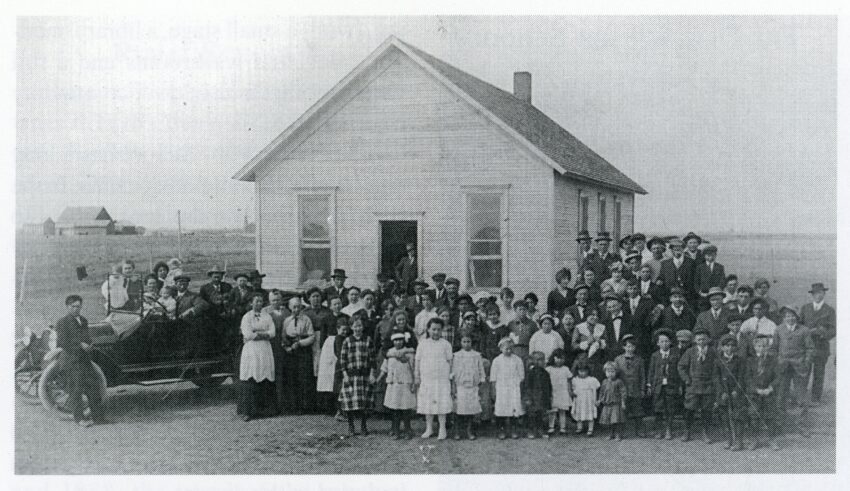[Excerpt from Dodge City and Ford County, Kansas 1870-1920 Pioneer Histories and Stories. Copyright Ford County Historical Society, Inc. All Rights reserved.]
The headline on the front page of the Dodge City Journal dated January 13, 1955, was surrounded by pictures of the country school north of Dodge City. It read: “Modern Rural School has Link with Past.”
The accompanying article written by Heinie Schmidt told the history of that school district that dates back to 1884. Much of his article is quoted in this rural school story.
“Many of the old customs, landmarks and people who represented the frontier in Southwest Kansas have disappeared from the modern scene. The old tree, the old schoolhouse and the old Literary Societies are some of the things that are gone. The people of the frontier however, left us a legacy which is the foundation of our present civilization.
“Northwest of Dodge City is the Prairie View School (often called the Pottorff, pronounced Put-off school). Today [in 1954] it is a modern building, [with] a small stage, a library, modern toilets and washrooms and a full basement that is used as a community meeting place.
The Prairie View School has a long reputation as a community center. In the early days, in fact, the activity was so marked at this center that Prairie View was known as the Mother of the Literary Societies.
School district No. 20 was organized July 30, 1884, at the home of James E. Zerbe. John Groendyke was the Superintendent of Schools. At that time, 30 sections of northwest Ford County were included in the district.
The first school officers in 1884 were Henry Schmid (name later changed to Smith), Director; James E. Zerbe, Treasurer; and R.H. Gamble, Clerk. Mrs. Clara Gingrich was the first teacher. Miss Anna Gingrich of Dodge City, said that her mother wrapped her brother, Clyde, two years old, in blankets and laid him in the wood box back of the stove while she taught school. Her salary was $25 a month for a three-month term.

This school, which was 70 years old in 1954, was probably the oldest rural school in the whole southwestern part of Kansas. It was the oldest in Ford County.
Still quoting from Heinie Schmidt’s article, he tells of a souvenir pamphlet given to the pupils by their teacher at the end of the school term in 1903.
The specially printed page gives the information,
Prairie View Public School, District No., 20,
Royal Township,
Ford County, Kansas.
Grace Sturgeon, Teacher.
Pupils who were listed for the year were Marieta Trujillo, Calvin Pottorff, Edna Bright, Agnes Nieto, Anna Nieto, Reyes Nieto, Tommy Nieto, Ora Mitchell, Josephine Nieto, Rosa Rumsey, Willie Converth, Florence Trujillo, Minnie Mitchell, Louis Converth, Bertha Converth, Lillie Converth and Frank Converth.
In 1903, the board was made up of S.R. Bright, Director; H.H . Wells, Clerk; and H.B. Wood, Treasurer.

The school was named “Prairie View” by the pupils the year that Grace Sturgeon taught there. She held a contest in which pupils suggested names for the school. Out of the many suggestions, “Prairie View” received the most votes.
Through the years, the parents realized that the literary society was a valuable addition to the 3 R’s taught during the school hours. No teacher was ever hired in those early days who would not agree to teach the students musical and dramatic contributions for the literary programs. These were held on every other Friday night. Those meetings were always joyous, fun-filled social events for the community. The young people, and even the adults, were encouraged to participate in those programs. Usually two or three times during the school term, box or pie suppers would follow the program. The decorated boxes were auctioned off to the highest bidder who then ate with the lady who had prepared it. Sometimes, a young fellow would have to pay dearly to get to eat with the girl of his choice. The money collected was used for some special event, usually to buy candy treats for the Christmas program. There was always a Christmas tree and Santa Claus always showed up.
Many former pupils who had participated in those literary programs admitted as adults that their ability to stand before an audience in various capacities was because of their training at the literary programs.

Playing party games had been popular entertainment dating back into the past for many generations. Nailed-down desks made it impossible to hold the parties in the school houses, but the Prairie View parents in the late teens, anxious to provide floor space close to home for the young people to play “Skip-To-My Lou,” “Miller Boy” and other such lively singing games, found a way. They nailed the desks by rows on to boards so that the desks could all be moved to one side of the room leaving plenty of floor space for the games. Those still living in the ’90s who were growing up in the late teens, twenties, and thirties have fond memories of those party games at Prairie View. With the consolidation of rural schools with those of the city in 1972, improved roads and fast automobiles, the Prairie View School District ceased to exist. With it went the Literary Society, the play party games and the community spirit. All have faded into the past.
Heinie Schmidt – Used by permission of the High Plains Journal
Adapted by Lola Adams Crum
Dodge City and Ford County, Kansas 1870-1920 Pioneer Histories and Stories is available for purchase from the Ford County Historical Society.

